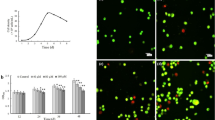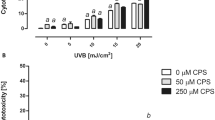Abstract
Hexavalent chromium Cr(VI) is a known human lung carcinogen, with solubility playing an important role in its carcinogenic potency. Dermal exposure to Cr(VI) is common and has been associated with skin damage; however, no link between chromate exposure and skin cancer has been found. In this study, we compared the cytotoxic and clastogenic effects of Cr(VI) and its impacts on cell cycle progression in human lung and skin fibroblasts. We found human skin cells arrested earlier in their cell cycle and exhibit more cytotoxicity than human lung cells, despite taking up similar amounts of Cr. These outcomes are consistent with a hypothesis that different cellular and molecular responses underlie the differences in carcinogenic outcome in these two tissues.






Similar content being viewed by others
References
OSHA (2009) Hexavalent Chromium. U.S. Department of Labor Occupational Safety and Health Administration 3373-10
IARC (2012) A Review of Human Carcinogens. C. Metals, Arsenic, Fibres and Dusts. Monogr Eval Carcinog Risks Hum 100C:1–512
NTP (National Toxicology Program) (2008) Toxicology and carcinogenesis studies of sodium dichromate dihydrate (Cas No. 7789-12-0) in F344/N rats and B6C3F1 mice (drinking water studies). Natl Toxicol Program Tech Rep Ser. 2008 ;(546):1-192.
Levy LS, Martin PA, Bidstrup PL (1986) Investigation of the potential carcinogenicity of a range of chromium containing materials on rat lung. Br J Ind Med 43:243–56
Patierno SR, Banh D, Landolph JR (1988) Transformation of C3H/10T1/2 mouse embryo cells to focus formation and anchorage independence by insoluble lead chromate but not soluble calcium chromate: relationship to mutagenesis and internalization of lead chromate particles. Cancer Res 48(18)):5280–8
Elias Z, Poirot O, Baruthio F, Danière MC (1991) Role of solubilized chromium in the induction of morphological transformation of Syrian hamster embryo (SHE) cells by particulate chromium(VI) compounds. Carcinogenesis 12(10):1811–6
Langård S (1993) Role of chemical species and exposure characteristics in cancer among persons occupationally exposed to chromium compounds. Scand J Work Environ Health 19:81–89
Wise JP Sr, Wise SS, Little JE (2002) The cytotoxicity and genotoxicity of particulate and solublehexavalent chromium in human lung cells. Mutat Res 517:221–9
Ishikawa Y, Nakagawa K, Satoh Y, Kitagawa T, Sugano H, Hirano T, Tsuchiya E (1994) Characteristics of chromate workers' cancers, chromium lung deposition and precancerous bronchial lesions: an autopsy study. Br J Cancer 70:160–166
Ishikawa Y, Nakagawa K, Satoh Y, Kitagawa T, Sugano H, Hirano T, Tsuchiya E (1994) "Hot spots" of chromium accumulation at bifurcations of chromate workers' bronchi. Cancer Res 54:2342–2346
Singh J, Pritchard DE, Carlisle DL, Mclean JA, Montaser A, Orenstein JM, Patierno SR (1999) Internalization of carcinogenic lead chromate particles by cultured normal human lung epithelial cells: formation of intracellular lead-inclusion bodies and induction of apoptosis. Toxicol Appl Pharmacol 161(3):240–8
Xie H, Holmes AL, Wise SS, Gordon N, Wise JP Sr (2004) Lead chromate-induced chromosome damage requires extracellular dissolution to liberate chromium ions but does not require particle internalization or intracellular dissolution. Chem Res Toxicol 17(10):1362–7
Holmes AL, Wise SS, Wise JP Sr (2008) Carcinogenicity of hexavalent chromium. Indian J Med Res 128(4):353–72, Review
Wise SS, Holmes AL, Ketterer ME, Hartsock WJ, Fomchenko E, Katsfis SP et al (2004) Chromium is the proximate clastogenic species for lead chromate-induced clastogenicity in human bronchial cells. Mutat Res 560:79–89
Mancuso TF (1997) Chromium as an industrial carcinogen: I. Chromium in human tissues. Am J Ind Med 31:140–147
Bencko V (1985) Chromium: a review of environmental and occupational toxicology. J Hyg Epidemiol Microbiol Immunol 29(1):37–46
Uddin AN, Burns FJ, Rossman TG, Chen H, Kluz T, Costa M (2007) Dietary chromium and nickel enhance UV-carcinogenesis in skin of hairless mice. Toxicol Appl Pharmacol 221(3):329–38
Shelnutt SR, Goad P, Belsito DV (2007) Dermatological toxicity of hexavalent chromium. Crit Rev Toxicol 37(5):375–87
Biedermann KA, Landolph JR (1990) Role of valence state and solubility of chromium compounds on induction of cytotoxicity, mutagenesis, and anchorage independence in diploid human fibroblasts. Cancer Res 50(24):7835–42
Wise JP, Leonard JC, Patierno SR (1992) Clastogenicity of lead chromate particles in hamster and human cells. Mutat Res 278(1):69–79
Ha L, Ceryak S, Patierno SR (2004) Generation of S phase-dependent DNA double strand breaks by Cr(VI) exposure: involvement of ATM in Cr(VI) induction of γH2AX. Carcinogenesis 25:2265–74
Xie H, Holmes AL, Young JL, Qin Q, Joyce K, Pelsue SC, Peng C, Wise SS, Jeevarajan AS, Wallace WT, Hammond D, Wise JP Sr (2009) Zinc chromate induces chromosome instability and DNA double strand breaks in human lung cells. Toxicol Appl Pharmacol 234(3):293–9. doi:10.1016/j.taap.2008.10.010
Holmes AL, Wise SS, Xie H, Gordon N, Thompson WD, Wise JP Sr (2005) Lead ions do not cause human lung cells to escape chromate-induced cytotoxicity. Toxicol Appl Pharmacol 203:167–76
Xie H, Wise SS, Holmes AL, Xu B, Wakeman T, Pelsue SC, Singh NP, Wise JP Sr (2005) Carcinogenic lead chromate induces DNA double-strand breaks and activates ATM kinase in human lung cells. Mutat Res 586:160–72
Lal MA, Bae D, Camilli TC, Patierno SR, Ceryak S (2009) AKT1 mediates bypass of the G1/S checkpoint after genotoxic stress in normal human cells. Cell Cycle 8(10):589–602
Pok S, Wen V, Shackel N, Alsop A, Pyakurel P, Fahrer A, Farrell GC, Teoh NC (2013) Cyclin E facilitates dysplastic hepatocytes to bypass G1/S checkpoint in hepatocarcinogenesis. J Gastroenterol Hepatol 28(9):1545–54. doi:10.1111/jgh.12216
Dou QP, An B, Will PL (1995) Induction of a retinoblastoma phosphatase activity by anticancer drugs accompanies p53-independent G1 arrest and apoptosis. Proc Natl Acad Sci USA 92(20):9019–23
Chen F, Harrison LE (2005) Ciglitazone-induced cellular anti-proliferation increases p27kip1 protein levels through both increased transcriptional activity and inhibition of proteasome degradation. Cell Signal 17(7):809–16
Hsiao CJ, Hsiao G, Chen WL, Wang SW, Chiang CP, Liu LY, Guh JH, Lee TH, Chung CL (2014) Cephalochromin induces G0/G1 cell cycle arrest and apoptosis in A549 human non-small-cell lung cancer cells by inflicting mitochondrial disruption. J Nat Prod 77(4):758–65. doi:10.1021/np400517g
Kaur J, Tikoo K (2013) Evaluating cell specific cytotoxicity of differentially charged silver nanoparticles. Food Chem Toxicol 1:1–14. doi:10.1016/j.fct.2012.08.044
Bastian S, Busch W, Kühnel D, Springer A, Meissner T, Holke R, Scholz S, Iwe M, Pompe W, Gelinsky M, Potthoff A, Richter V, Ikonomidou C, Schirmer K (2009) Toxicity of tungsten carbide and cobalt-doped tungsten carbide nanoparticles in mammalian cells in vitro. Environ Health Perspect 117(4):530–6
Zhang T, Stilwell JL, Gerion D, Ding L, Elboudwarej O, Cooke PA, Gray JW, Alivisatos AP, Chen FF (2006) Cellular effect of high doses of silica-coated quantum dot profiled with high throughput gene expression analysis and high content cellomics measurements. Nano Lett 6(4):800–8
Li Chen T, LaCerte C, Wise SS, Holmes A, Martino J, Wise JP Jr, Thompson WD, Wise JP Sr (2012) Comparative cytotoxicity and genotoxicity of particulate and soluble hexavalent chromium in human and sperm whale (Physetermacrocephalus) skin cells. Comp Biochem Physiol C Toxicol Pharmacol 155(1):143–50. doi:10.1016/j.cbpc.2011.03.011
McNeill DR, Wong HK, Narayana A, Wilson DM 3rd (2007) Lead promotes abasic site accumulation and co-mutagenesis in mammalian cells by inhibiting the major abasic endonuclease Ape1. Mol Carcinog 46(2):91–9
Gastaldo J, Viau M, Bencokova Z, Joubert A, Charvet AM, Balosso J, Foray N (2007) Lead contamination results in late and slowly repairable DNA double-strand breaks and impacts upon the ATM-dependent signaling pathways. Toxicol Lett 173(3):201–14
Acknowledgments
We would like to thank Shouping Huang and Chris Gianios for administrative and technical support. We would like to thank Geron Corporation for the use of the hTERT materials. This work was supported by NIEHS grant ES016893 (J.P.W.) and the Maine Center for Toxicology and Environmental Health at the University of Southern Maine.
Conflict of interest
Author John Pierce Wise Sr. received funding from NIEHS (described above) and the Maine Center for Toxicology and Environmental Health which helped support this work.
Author information
Authors and Affiliations
Corresponding author
Additional information
John Pierce Wise, Sr. holds a PhD degree, University of Southern Maine.
Rights and permissions
About this article
Cite this article
Xie, H., Holmes, A.L., Wise, S.S. et al. Human Skin Cells Are More Sensitive than Human Lung Cells to the Cytotoxic and Cell Cycle Arresting Impacts of Particulate and Soluble Hexavalent Chromium. Biol Trace Elem Res 166, 49–56 (2015). https://doi.org/10.1007/s12011-015-0315-6
Received:
Accepted:
Published:
Issue Date:
DOI: https://doi.org/10.1007/s12011-015-0315-6




